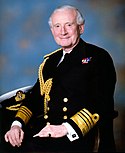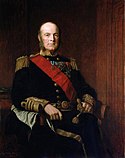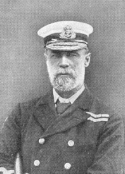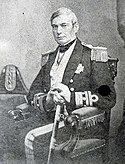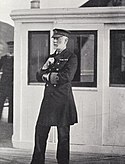Erster Seelord
| Erster Seelord und Chef des Marinestabs | |
|---|---|
| First Sea Lord and Chief of the Naval Staff | |
 | |
| Flagge der Royal Navy | |
 | |
| Amtierend Ben Key seit dem 8. November 2021 | |
| Amtssitz | Verteidigungsministerium, Whitehall, London |
| Amtszeit | At His Majesty’s pleasure |
| Ernennung durch | King-in-Council |
| Schaffung des Amtes | 1689 |
| Erster Amtsinhaber | Arthur Herbert, 1. Earl of Torrington |
| Website | [1] |
Erster Seelord und Chef des Marinestabs (englisch First Sea Lord and Chief of the Naval Staff) ist im Vereinigten Königreich heute die ranghöchste Dienststellung innerhalb der Royal Navy. Der Erste Seelord ist heute innerhalb des britischen Verteidigungsministeriums zugleich Chef des Stabes der Royal Navy (Chief of Naval Staff). Die Abkürzung lautet 1SL/CNS. Das Amt ist nicht zu verwechseln mit dem des Ersten Lords der Admiralität, das der Funktion des Marineministers entspricht.
Geschichte
Die Dienststellung des Ersten Seelords ist aus dem Posten des First Naval Lord hervorgegangen, der von 1828 bis 1904 existierte. Die Position änderte sich im Lauf der Geschichte, wobei die Geschichte des Ersten Seelords eng mit der Geschichte der britischen Admiralität verbunden ist.
Ursprünglich lag die Verantwortung für die Führung der Royal Navy bei einer einzelnen Person, dem Lord High Admiral. Ab dem 18. Jahrhundert wurde diese Aufgabe aber meist durch einen Ausschuss erfüllt, das Board of Admiralty. Die Mitglieder dieses Ausschusses wurden als Lords Commissioner of the Admiralty bezeichnet und setzten sich aus Admiralen der Royal Navy sowie aus Zivilisten zusammen. Die Admirale im Board of Admiralty wurden als „Seelords“ bezeichnet. Es gab davon zuletzt fünf, wobei dem Ersten Seelord die operative Leitung der Royal Navy unterstand. Den Vorsitz über das gesamte Board of Admiralty führte der First Lord of the Admiralty („Erster Lord der Admiralität“), der üblicherweise dem Kabinett angehörte und nach 1806 stets ein Zivilist war. Er hatte die politische Verantwortung für die Royal Navy zu tragen und wurde von daher auch als „Marineminister“ bezeichnet.
Die beschriebene Organisationsstruktur innerhalb der britischen Admiralität bestand noch bis in die zweite Hälfte des 20. Jahrhunderts. 1964 wurden alle bisherigen Funktionen der Admiralität dem in diesem Jahr neu geschaffenen Verteidigungsministerium des Vereinigten Königreichs übertragen. Innerhalb des Verteidigungsministeriums wurden neue Dienststellen geschaffen, die zum Teil die Namen früherer Behörden erhielten, und auch der Name Erster Seelord für den operativen Leiter der Royal Navy wurde nach 1964 weiter beibehalten.
Das formelle Flaggschiff des Ersten Seelords war die Victory von 1737. Nachdem die Victory 1744 im Sturm gesunken war, wurde die Victory von 1759 das neue Flaggschiff, das es auch bis heute noch ist, obwohl es als Museumsschiff im Portsmouth Historic Dockyard im Trockendock liegt. Bekanntheit erlangte die Victory als Flaggschiff von Vizeadmiral Nelson in der Seeschlacht von Trafalgar und ist das älteste in Dienst befindliche Kriegsschiff.
First Naval Lords (1828–1904)
| Bild | Amtsinhaber | Amtszeit |
|---|---|---|
 | Admiral of the Fleet Sir George Cockburn, 10. Baronet | 1828–1830 |
 | Vice-Admiral of the Blue Sir Thomas Masterman Hardy, 1. Baronet | 1830–1834 |
 | Rear Admiral George Heneage Lawrence Dundas | 1834 |
 | Admiral Sir Charles Adam | 1834 |
 | Admiral of the Fleet Sir George Cockburn, 10. Baronet | 1834–1835 |
 | Admiral Sir Charles Adam | 1835–1841 |
 | Admiral of the Fleet Sir George Cockburn, 10. Baronet | 1841–1846 |
 | Vice Admiral Sir William Parker, 1. Baronet | 1846 |
 | Admiral Sir Charles Adam | 1846–1847 |
 | Admiral Sir James Whitley Deans Dundas | 1847–1852 |
 | Admiral Sir Maurice Frederick FitzHardinge Berkeley | 1852 |
| Vice-Admiral Hyde Parker | 1852–1854 | |
 | Admiral Sir Maurice Frederick FitzHardinge Berkeley | 1854–1857 |
 | Vice Admiral Sir Richard Saunders Dundas | 1857–1858 |
| Admiral Sir William Fanshawe Martin, 4. Baronet | 1858–1859 | |
 | Vice Admiral Sir Richard Saunders Dundas | 1859–1861 |
| Admiral Sir Frederick William Grey | 1861–1866 | |
 | Admiral of the Fleet Sir Alexander Milne, 1. Baronet | 1866–1868 |
 | Admiral Sir Sydney Colpoys Dacres | 1868–1872 |
 | Admiral of the Fleet Sir Alexander Milne, 1. Baronet | 1872–1876 |
 | Admiral Sir Hastings Yelverton | 1876–1877 |
 | Admiral Sir George Wellesley | 1877–1879 |
 | Admiral Sir Astley Cooper Key | 1879–1885 |
 | Admiral Arthur Hood, 1. Baron Hood of Avalon | 1885–1886 |
 | Admiral of the Fleet Lord John Hay | 1886 |
 | Admiral Arthur Hood, 1. Baron Hood of Avalon | 1886–1889 |
 | Admiral Sir Richard Vesey Hamilton | 1889–1891 |
 | Admiral Sir Anthony Hoskins | 1891–1893 |
 | Admiral of the Fleet Sir Frederick Richards | 1893–1899 |
 | Admiral of the Fleet Lord Walter Kerr | 1899–1904 |
First Sea Lords (1904–heute)
| Bild | Amtsinhaber | Amtszeit |
|---|---|---|
 | Admiral of the Fleet Sir John Fisher | 1904–1910 |
 | Admiral of the Fleet Sir Arthur Wilson | 1910–1911 |
 | Admiral Sir Francis Charles Bridgeman | 1911–1912 |
 | Admiral Prinz Ludwig Alexander von Battenberg | 1912–1914 |
 | Admiral of the Fleet John Fisher, 1. Baron Fisher | 1914–1915 |
 | Admiral Sir Henry Bradwardine Jackson | 1915–1916 |
 | Admiral of the Fleet John Jellicoe, 1. Earl Jellicoe | 1916–1917 |
 | Admiral of the Fleet Rosslyn Wemyss, 1. Baron Wester Wemyss | 1917–1919 |
 | Admiral of the Fleet David Beatty, 1. Earl Beatty | 1919–1927 |
 | Admiral of the Fleet Sir Charles Madden, 1. Baronet | 1927–1930 |
 | Admiral of the Fleet Sir Frederick Field | 1930–1933 |
 | Admiral of the Fleet Ernle Chatfield, 1. Baron Chatfield | 1933–1938 |
 | Admiral Sir Roger Backhouse | 1938–1939 |
 | Admiral of the Fleet Sir Dudley Pound | 1939–1943 |
| Admiral of the Fleet Andrew Cunningham, 1. Viscount Cunningham of Hyndhope | 1943–1946 | |
| Admiral of the Fleet Sir John Cunningham | 1946–1948 | |
 | Admiral of the Fleet Bruce Fraser, 1. Baron Fraser of North Cape | 1948–1951 |
 | Admiral of the Fleet Sir Rhoderick McGrigor | 1951–1955 |
 | Admiral of the Fleet Louis Mountbatten, 1. Earl Mountbatten of Burma | 1955–1959 |
| Admiral of the Fleet Sir Charles Lambe | 1959–1960 | |
| Admiral of the Fleet Sir Caspar John | 1960–1963 | |
| Admiral Sir David Luce | 1963–1966 | |
| Admiral of the Fleet Sir Varyl Begg | 1966–1968 | |
| Admiral of the Fleet Sir Michael Le Fanu | 1968–1970 | |
| Admiral of the Fleet Sir Peter Hill-Norton | 1970–1971 | |
| Admiral of the Fleet Sir Michael Pollock | 1971–1974 | |
| Admiral of the Fleet Sir Edward Beckwith Ashmore | 1974–1977 | |
| Admiral of the Fleet Sir Terence Lewin | 1977–1979 | |
| Admiral of the Fleet Sir Henry Leach | 1979–1982 | |
| Admiral of the Fleet Sir John Fieldhouse | 1982–1985 | |
| Admiral of the Fleet Sir William Staveley | 1985–1989 | |
| Admiral of the Fleet Sir Julian Oswald | 1989–1993 | |
| Admiral of the Fleet Sir David Benjamin Bathurst | 1993–1995 | |
 | Admiral Sir John Cunningham Kirkwood Slater | 1995–1998 |
 | Admiral Sir Michael Boyce | 1998–2001 |
| Admiral Sir Nigel Essenhigh | 2001–2002 | |
 | Admiral Sir Alan West | 2002–2006 |
| Admiral Sir Jonathon Band | 2006–2009 | |
 | Admiral Sir Mark Stanhope | 2009–2013 |
 | Admiral Sir George Zambellas | 2013–2016 |
| Admiral Sir Philip Jones | 2016–2019 | |
 | Admiral Sir Tony Radakin | 2019–2021 |
 | Admiral Sir Ben Key | Seit 2021 |
Literatur
- Malcolm H. Murfett (Hrsg.): The First Sea Lords. From Fisher to Mountbatten. Praeger, Westport CT u. a. 1995, ISBN 0-275-94231-7.
Auf dieser Seite verwendete Medien
The Royal Navy Admiral Sir Michael Cecil Boyce, United Kingdom Chief of Defense, at the Pentagon.
IWM caption : Vice Admiral McGrigor CB, DSO, commander of a cruiser squadron, stood under some of the 8 inch guns of his flagship HMS NORFOLK at Oslo, Norway.
Admiral Sir George Wellesley. Caption: The Late Admiral Sir G. G. Wellesley, Distinguished Naval Officer
Autor/Urheber: Katie Chan, Lizenz: CC BY-SA 3.0
Former First Sea Lord Admiral the Right Honourable Baron West of Spithead GCB DSC PC ADC at the 2013 Merchant Navy Day Commemorative Service and Reunion at Trinity Square Gardens.
Caricature of Admiral Sir Anthony Hiley Hoskins GCB (1828-1901). Caption read "Naval Reserves".
Captain (later admiral of the fleet) John Jellicoe - Project Gutenberg eText 16363
Autor/Urheber: Royal Navy, Lizenz: OGL 3
The torch of Naval leadership today changed hands as Admiral Sir Ben Key became the nation’s most senior sailor.Aboard Nelson’s flagship Victory, he took over as First Sea Lord from Admiral Sir Tony Radakin, whose 29 months at the helm end as he moves on to become the new Chief of Defence Staff.He formally handed over command of more than 30,000 men and women, more than 90 warships, nuclear submarines and support vessels, the helicopters and jets of the Fleet Air Arm and the elite Naval infantry of the Royal Marines to the man who has been Chief of Joint Operations and a former Fleet Commander.During his command, Admiral Key will see the lead ships of two new classes of frigate– submarine hunter HMS Glasgow, the first of eight Type 26 warships and general purpose HMS Venturer, the maiden Inspiration-class/Type 31 vessel – enter the water and will continue the transformation of the Royal Navy spearheaded by his predecessor, re-shaping the Service to meet the challengesand demands of the mid-21st Century.The historic setting of HMS Victory’s great cabin was the venue for the transfer of office. Proceedings then shifted to Victory’s quarterdeck and the last act of the ceremony, where Admiral Radakin’s standard was lowered and Admiral Key’s flag raised in its place.Adm Key’s service has seen him qualify as both helicopter crew and as a Principal Warfare Officer, command four ships, including aircraft carrier HMS Illustrious, serve as Flag Officer Sea Training, Fleet Commander, and Chief of Joint Operations.
Admiral George Heneage Dundas
Admiral of the Fleet Sir Roger Backhouse
Admiral Astley Cooper Key - From a print by the London Steroscopic Company
A 1922 portrait of Admiral of the Fleet Sir Charles Edward Madden, 1st Baronet, GCB, OM, GCVO, KCMG (5 September 1862 – 5 June 1935), a Royal Navy officer who was Chief of the Staff to Sir John Jellicoe from 1914 to 1916 and Second-in-Command to Sir David Beatty from 1916 to 1919. He was Commander-in-Chief, Atlantic Fleet after the War and served as First Sea Lord in the late 1920s.
Prince Louis Alexander of Battenberg (Louis Alexander Mountbatten), 1854-1921. British admiral.
IWM caption : Admiral Sir Bruce Fraser, Commander in Chief of the Royal Navy Home Fleet May 1943 to June 1944. In 1944 he became Commander in Chief of the British Pacific Fleet. Photograph taken on board HMS DUKE OF YORK at Guam.
Autor/Urheber: Royal Navy, Lizenz: OGL v1.0
Official photo of en:Jock Slater
Caricature of Admiral Sir Hastings Reginald Yelverton, GCB (1808-1878). Caption read "Spanish Ironclads".
Admiral Frederick Richards
Photograph shows Admiral of the Fleet John Arbuthnot "Jacky" Fisher, 1st Baron Fisher of Kilverstone (1841-1920) who served in the British Royal Navy. (Source: Flickr Commons project, 2012)
Admiral Sir Charles Adam - early 19th century portrait (Scottish National Portrait Gallery) NOTE (2018): There is no record of this image on the Scottish National Portrait Gallery website, nor does there seem to be any other image illustrating Admiral Charles Adam online. More information about this portrait is needed to ensure it is correctly identified.
Autor/Urheber: UNC - CFC - USFK, Lizenz: CC BY 2.0
General Walter L. Sharp walks with the First Sea Lord, Admiral Sir Mark Stanhope, during a special dinner in his honor. (U.S. Army Photo By PFC Amber Smith)
Admiral Sir Henry Bradwardine Jackson (1855–1929) was the First Sea Lord of the Admiralty from 1915 to 1916 during the First World War. Photo from The War Illustrated, 26 June 1915. Caption reads: :Admiral Sir Henry Bradwardine Jackson K.C.B., K.C.V.O., F.R.S., A.I.N.A., M.I.E.E.
Maurice Berkeley, 1st Baron FitzHardinge, from the Berkeley Castle Collection
Admiral Sir John Cunningham
Autor/Urheber: Royal Navy, Lizenz: OGL v1.0
Vice Admiral Sir Philip Jones, Fleet Commander of the Royal Navy, talking to a sailor at a formal inspection
WASHINGTON (April 13, 2009) Adm. Sir Jonathon Band, GCB, ADC, First Sea Lord and Chief of Naval Staff of the Royal Navy, left, speaks with a Sailor from the U.S. Navy Ceremonial Guard at the Washington Navy Yard during an arrival ceremony hosted by Chief of Naval Operations Adm. Gary Roughead. (U.S. Navy photo by Joseph P Cirone/Released)
Admiral Sir Francis Charles Bridgeman Bridgeman (1848-1929)
Admiral of the Fleet Sir Ernle Chatfield
Sir Alfred Dudley Pickman Rogers Pound, British Admiral of the Fleet, First Sea Lord, head of the Royal Navy, June 1939–1943
Autor/Urheber: Allan Warren , Lizenz: CC BY-SA 3.0
Earl Mountbatten of Burma
Autor/Urheber: LA(Phot) Allen, Lizenz: OGL v1.0
Admiral Sir George Zambellas KCB DSC is to be appointed First Sea Lord and Chief of the Naval Staff, in succession to Admiral Sir Mark Stanhope GCB OBE ADC in April 2013.
Admiral Sir Sydney Dacres - from a 19th century photo labeled Rear-Admiral Sydney Dacres CB First Sea Lord 1868-72
Captain Thomas Masterman Hardy - from the painting by Richard Evans, at Greenwich Hospital.
ANNAPOLIS, Md. (November 20, 2019) U.S. Naval Academy Superintendent, Vice Adm. Sean Buck, hosts a walking tour of the yard for First Sea Lord, United Kingdom Royal Navy, Adm. Tony Radakin and Chief of Staff of the Japan Maritime Self-Defence Force, Adm. Hiroshi Yamamura.
Admiral Sir Richard Vesey Hamilton
Rear Admiral David Beatty of the Royal Navy.
Admiral lord Walter Kerr. Taken by a Royal Navy official photograph in 1895.
Sir William Parker















